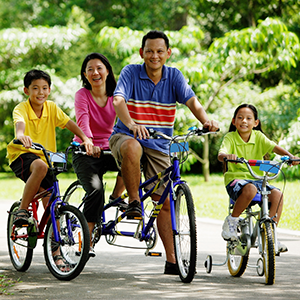Childhood may seem to move at a faster pace these days, but children don’t.
New research from the American Heart Association shows that today’s
children are slower and less fit than their parents were: modern kids take
about 90 seconds longer to run a mile than their predecessors did 30 years
ago, and children’s cardiovascular fitness has dropped 5 percent per decade
since 1975. This problem isn’t confined to the U.S., either. According to
the World Health Organization, up to 80 percent of the world’s children
aren’t getting enough exercise.
You can reverse this troubling trend at home, though. These family fitness
tactics for kids of every age will help your brood embrace better health,
improve their energy and have more fun.
TODDLER-PRESCHOOL YEARS 2-5: Family Flex
The good news: Toddlers usually get plenty of exercise, says Beverly J.
Allen, Ph.D., professor of Physical Education and Recreation at North
Carolina Central University in Durham. “Children this age are very active
and get the exercise they need from running, jumping, climbing, rolling,
bending, pulling, pushing and dancing.” Help preschool-age kids get
physical by playing tag together, wrestling and asking kids to put away
toys one at a time or ferry items up and down stairs.
But don’t encourage copycat workouts – very young kids shouldn’t follow
along with certain grown-up exercises, says Coach Dale Speckman, director
and head trainer at Athletic Revolution of Northeast Indianapolis. “Young
children simply aren’t ready for high repetition, high intensity workouts
like jogging or interval training,” he says. If kids want to work out with
you, do some simple exercises using their own body weight like lunges,
planks and squats.
ELEMENTARY YEARS 6-12: Unsportsmanlike Conduct
For kids who like sports, the elementary years bring a whirlwind of new
opportunities to stay active, from soccer to softball. But less athletic
kids may begin to shirk exercise, particularly if they feel inept at
sports. Fortunately, competitive sports play isn’t the only way kids can
get needed exercise, says Allen. Parents can encourage kids of all stripes
– sports lovers and sports avoiders alike – to get enough exercise by
establishing a regular family outing, like ice skating, swimming or a long
outdoor walk. Visit parks and public spaces where kids can be active, and
explore less competitive physical pursuits like biking, skateboarding and
gymnastics.
Whatever pastimes kids gravitate toward, it’s important for parents to
model that physical activity is enjoyable, says Allen. “Make sure kids have
access to fun equipment like skates, Frisbees and hula hoops. And remember
that physical activity is important for all children, including those with
a disability. Your child’s pediatrician can tell you more about the amounts
and types of physical activity that are appropriate for your child’s
ability.”
TEEN YEARS 13-18: Safe Shred
Trend-loving teens may hop on the latest fitness bandwagon to attain a
“shredded” (teen-speak for well-defined or muscular) physique. But high
intensity workouts like CrossFit and P90x aren’t suited for teenagers, says
Speckman. “CrossFit utilizes many Olympic-style lifts that are extremely
technical and require high levels of joint mobility and stability. These
technical lifts take several weeks to teach in order to perform safely and
effectively.” Sports injuries are on the rise in children and teenagers,
something experts attribute to early sport specialization and teens with
still-growing bodies performing too many repetitions – something CrossFit
may encourage. Parents of young fitness enthusiasts should seek trainers
that are certified in youth fitness, Speckman adds. Even if a trainer has a
background in strength or sports training, youth training is vastly
different and should be left to a certified professional.

